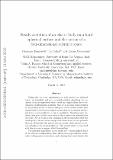| dc.contributor.author | Tomassetti, Giuseppe | |
| dc.contributor.author | Cohen, Tal | |
| dc.contributor.author | Abeyaratne, Rohan | |
| dc.date.accessioned | 2018-12-07T15:44:13Z | |
| dc.date.available | 2018-12-07T15:44:13Z | |
| dc.date.issued | 2016-03 | |
| dc.date.submitted | 2016-03 | |
| dc.identifier.issn | 0022-5096 | |
| dc.identifier.uri | http://hdl.handle.net/1721.1/119463 | |
| dc.description.abstract | Taking the cue from experiments on actin growth on spherical beads, we formulate and solve a model problem describing the accretion of an incompressible elastic solid on a rigid sphere due to attachment of diffusing free particles. One of the peculiar characteristics of this problem is that accretion takes place on the interior surface that separates the body from its support rather than on its exterior surface, and hence is responsible for stress accumulation. Simultaneously, ablation takes place at the outer surface where material is removed from the body. As the body grows, mechanical effects associated with the build-up of stress and strain energy slow down accretion and promote ablation. Eventually, the system reaches a point where internal accretion is balanced by external ablation. The present study is concerned with this stationary regime called “treadmilling”. The principal ingredients of our model are: a nonstandard choice of the reference configuration, which allows us to cope with the continually evolving material structure; and a driving force and a kinetic law for accretion/ablation that involves the difference in chemical potential, strain energy and the radial stress. By combining these ingredients we arrive at an algebraic system which governs the stationary treadmilling state. We establish the conditions under which this system has a solution and we show that this solution is unique. Moreover, by an asymptotic analysis we show that for small beads the thickness of the solid is proportional to the radius of the support and is strongly affected by the stiffness of the solid, whereas for large beads the stiffness of the solid is essentially irrelevant, the thickness being proportional to a characteristic length that depends on the parameters that govern diffusion and accretion kinetics. | en_US |
| dc.publisher | Elsevier BV | en_US |
| dc.relation.isversionof | http://dx.doi.org/10.1016/J.JMPS.2016.05.015 | en_US |
| dc.rights | Creative Commons Attribution-NonCommercial-NoDerivs License | en_US |
| dc.rights.uri | http://creativecommons.org/licenses/by-nc-nd/4.0/ | en_US |
| dc.source | arXiv | en_US |
| dc.title | Steady accretion of an elastic body on a hard spherical surface and the notion of a four-dimensional reference space | en_US |
| dc.type | Article | en_US |
| dc.identifier.citation | Tomassetti, Giuseppe, Tal Cohen, and Rohan Abeyaratne. “Steady Accretion of an Elastic Body on a Hard Spherical Surface and the Notion of a Four-Dimensional Reference Space.” Journal of the Mechanics and Physics of Solids 96 (November 2016): 333–352. © 2016 Elsevier Ltd | en_US |
| dc.contributor.department | Massachusetts Institute of Technology. Department of Mechanical Engineering | en_US |
| dc.contributor.mitauthor | Abeyaratne, Rohan | |
| dc.relation.journal | Journal of the Mechanics and Physics of Solids | en_US |
| dc.eprint.version | Author's final manuscript | en_US |
| dc.type.uri | http://purl.org/eprint/type/JournalArticle | en_US |
| eprint.status | http://purl.org/eprint/status/PeerReviewed | en_US |
| dc.date.updated | 2018-12-04T13:30:19Z | |
| dspace.orderedauthors | Tomassetti, Giuseppe; Cohen, Tal; Abeyaratne, Rohan | en_US |
| dspace.embargo.terms | N | en_US |
| dc.identifier.orcid | https://orcid.org/0000-0003-2912-1538 | |
| mit.license | PUBLISHER_CC | en_US |
